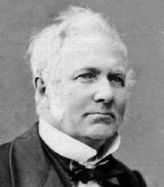Giusto Bellavitis facts for kids
Quick facts for kids
Giusto Bellavitis
|
|
|---|---|
 |
|
| Born | November 22, 1803 Bassano, Vicenza
|
| Died | November 6, 1880 (aged 76) Tezze sul Brenta (near Bassano)
|
| Nationality | Italian |
| Alma mater | University of Padua |
| Known for | Equipollence |
| Spouse(s) | Maria Tavelli |
| Scientific career | |
| Fields | Geometry |
| Institutions | University of Padua |
Giusto Bellavitis (born November 22, 1803 – died November 6, 1880) was an important Italian mathematician. He also served as a senator and a local council member in Italy.
He is best known for inventing a special method in geometry called "equipollence." This new way of looking at shapes and lines was very clever and useful.
Contents
About Giusto Bellavitis
Giusto Bellavitis was born in a town called Bassano del Grappa in 1803. His parents were Ernesto Bellavitis and Giovanna Navarini. He mostly taught himself what he knew.
In 1840, he joined an important group called the Institut Venitian. Two years later, in 1842, he started teaching at a school in Vicence.
Teaching Career
In 1845, Giusto Bellavitis became a professor at the University of Padua. He taught a type of geometry called descriptive geometry. When Italy became a united country, he helped change the school's lessons. He made sure that subjects like algebra and analytic geometry were included.
Bellavitis got married in 1842. He had one son, who also grew up to teach geometry at the University of Padua.
What is Equipollence?
Giusto Bellavitis came up with the idea of "equipollence." This idea was a bit like what we now call a Euclidean vector.
Understanding Equipollence
Imagine two straight lines, like AB and CD. Bellavitis said they are "equipollent" if they meet three conditions:
- They are parallel (they never cross).
- They have the exact same length.
- They point in the same direction.
Mathematicians write this as  This idea of equipollence is a type of "equivalence relation." It means that if two things are equipollent, they are considered the same in a certain way.
This idea of equipollence is a type of "equivalence relation." It means that if two things are equipollent, they are considered the same in a certain way.
Adding with Equipollence
Bellavitis also showed how to "add" these equipollent lines. He wrote it like this:  This is similar to how we think about vector addition today. If you go from A to B, and then from B to C, it's the same as going directly from A to C.
This is similar to how we think about vector addition today. If you go from A to B, and then from B to C, it's the same as going directly from A to C.
Giusto Bellavitis wrote many papers and books. He wrote about many different subjects, not just math! These included arithmetic, algebra, geometry, and even astronomy and chemistry.
His Works
Here are some of the important books and papers Bellavitis wrote:
- 1852: Saggio sull'algebra degli immaginari (An Essay on the Algebra of Imaginary Numbers)
- 1854: Sposizione del Metodo della Equipollenze (Explanation of the Method of Equipollences)
- 1858: Calcolo dei Quaternioni di W.R. Hamilton e sua Relazione col Metodo delle Equipollenze (Calculus of Quaternions by W.R. Hamilton and its Relation to the Method of Equipollences)
- 1868: Lezioni di Geometria Descrittiva, 2nd edition (Lessons in Descriptive Geometry, 2nd edition)
Awards and Recognition
Giusto Bellavitis received several important awards for his work:
- In 1840, he became a Fellow of the Istituto Veneto. This is a prestigious academic institution.
- In 1850, he became a Fellow of the Società Italiana dei Quaranta. This is another important Italian scientific society.
- In 1879, he became a Member of the Accademia dei Lincei. This is one of the oldest and most respected scientific academies in the world.
See also
 In Spanish: Giusto Bellavitis para niños
In Spanish: Giusto Bellavitis para niños


